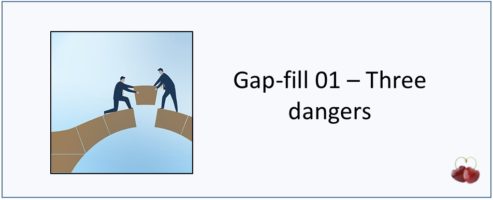43 – Gap-fill 01 – Three dangers
This is the first post in a series of four on the topic of gap-fill exercises, and how consideration of what they require can lead to a new approach to decoding – ‘learning the sound substance of English’.
Decoding (when it does occur) most often happens at the end of a listening comprehension exercise. And perhaps the most common type of decoding exercise is the gap-fill.
The gap-fill is a useful focussing device, but there are three dangers in using it.
- (a) being satisfied with the right answer
- (b) mistaking the sight substance for sound substance
- (c) the single instance problem.
Before we discuss these dangers, it is useful to have an example of a gap-fill exercise in mind. Let’s imagine one in which students have completed a conventional listening comprehension exercise which focussed on the role of dancing in social life in Spain. So by the time students come to do decoding, they are familiar with the topic, with the voices on the recording, the purposes and outcomes of the interaction, with the meanings communicated. And then, to finish the listening lesson, you give them the following target sentence with a gap to be filled:
| You have to really ________ salsa dance |
And the words that need to go into the gap are ‘be able to’ – and these three words sound like this:
Danger 1: Being satisfied with right answer
It may be that one person in the class recognises or guesses what the words are, the teacher says ‘That’s right! Well done!’, and everyone goes ‘Oh it’s that!’ and writes in the answer. The fleeting, fast-moving sound substance is replaced by permanent, non-moving sight substance, and everyone is content that good work has been done. But usually, there has been no inspection or discussion of the sound substance, no discussion of why the words sounded in the way they did, nor any attempt to explain the differences between the sound shapes that occurred, and the citation forms of those words.. My wish would be that there is inspection and discussion of the soundshapes that occurred, and that we view decoding as teaching the sound substance of the language. Before we go on, we need to define ‘sight substance’ and ‘sound substance’ …
The term ‘sight substance’ refers to the written form of the language that you (and your students) can see and inspect at a speed which is comfortable for you (cf. A Syllabus for Listening – Decoding Chapter 1). In contrast, the term ‘sound substance’ refers to the spoken form of the language which you cannot see or inspect and goes at the speed of the speaker.
Danger 2: Mistaking sight for sound
The gap-fill is a predominantly a sight-substance task. It starts with gapped sight substance, and ends with ungapped (completed) sight substance. Between the start and the end of the exercise there are repeated aural glimpses of the sound substance version of the target sentence, and students have to match words they know with the sound substance, and write them in the gaps. The repeated playing of the sound file gives students aural glimpses of the blurred mush of sound as it flies by. The danger is that we consider the goal of the task as the successful completion of the visible sight substance rather than learning about the sound substance of the language. My wish would be that we devote time to exploring the relationship between the blurred mush of sound, and the words that the mush represents. This (again) means teaching the sound substance of the language, teaching that words and word clusters have a variety of soundshapes which can differ markedly from citation forms. Here again is the sound file which contains the blurred mush which corresponds to be able to.
Danger 3: The single instance problem
The exercise involves repeated aural glimpses of one example of how the words to be able can sound – and it is possible, but by no means certain, that if students hear these or similar soundshapes again that they will recognise the words more easily. But for any set of words there is a large number of possible soundshapes, and my wish would again be that we should explore and learn how to handle a wider range of soundshapes than those in this single instance. For example, all of these soundshapes of able:
More on this in the forthcoming blogs.
Image from here.


